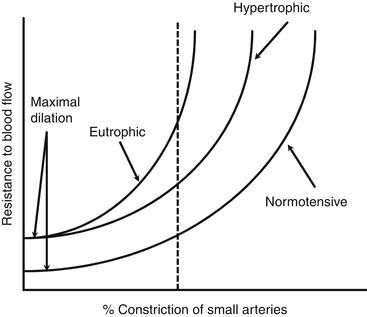Fig. 5.1
Remodeling of small arteries and arterioles in hypertension is inward (smaller lumen) and could be eutrophic, with no increase in the media cross-sectional area despite a thickened media (in essential hypertension), or it could be hypertrophic, in which case the media cross-sectional area is increased (generally associated with severe or secondary forms of hypertension). In both, media-to-lumen ratio (M/L) is greater than in normotension. Media cross-sectional area is calculated as πr o 2−πr i 2

Fig. 5.2
Folkow’s model shows that at each level of vascular constriction (e.g., at the level of the dashed vertical line), resistance to blood flow is increased more in eutrophic remodeling than in hypertrophic remodeling; and in the latter, resistance to flow is greater than in vessels from normotensive subjects
5.4 Rarefaction of Arterioles and Capillaries
Rarefaction is another type of remodeling that is found in hypertension. It occurs at the level of small arterioles with a lumen diameter smaller than 40 μm and capillaries [1]. With rarefaction, the density of arterioles and capillaries in tissues is diminished and consequently vascular resistance is increased [72, 73] and tissue perfusion is impaired [74]. Arteriolar rarefaction is functional initially as a result of vasoconstriction, and later anatomical and permanent, followed by rarefaction of capillaries with decreased tissue perfusion. Decreases in tissue perfusion have been associated with vascular complications and cardiovascular events [75].
5.5 Conclusion
Vascular remodeling and endothelial dysfunction in small resistance arteries are features regularly reported in hypertension. Functional, structural, and mechanical alterations of resistance arteries are probably the earliest alterations in the vasculature found in hypertensive subjects younger than 60 years of age. They take the form of eutrophic inward remodeling accompanied by endothelial dysfunction associated eventually to enhanced stiffness. These changes have been shown to have prognostic significance with respect to outcomes. They could contribute through wave reflection to increases in stiffness of large arteries and thus to systolic hypertension and the increased pulse pressure found in older subjects with hypertension. Alternatively, increased large artery stiffness could increase pulsatility, which when conducted into the microcirculation, may cause injury and remodeling of small arteries and arterioles. Activation of the RAAS plays a key role in vascular remodeling and endothelial dysfunction through redox-sensitive pathways that promote growth and inflammation in the blood vessel wall.
Disclosure
This study was supported by CIHR grants 13570, 37917, 82790, and 102606, a Canada Research Chair on Hypertension and Vascular Research from the CRC/CIHR Program of the Government of Canada, and a Canada Fund for Innovation grant, all to ELS.
References
1.
2.
3.
4.
5.
De Ciuceis C, Amiri F, Brassard P et al (2005) Reduced vascular remodeling, endothelial dysfunction, and oxidative stress in resistance arteries of angiotensin II-infused macrophage colony-stimulating factor-deficient mice: evidence for a role in inflammation in angiotensin-induced vascular injury. Arterioscler Thromb Vasc Biol 25:2106–2113CrossRefPubMed
6.
Savoia C, Schiffrin EL (2007) Reduction of C-reactive protein and the use of the anti-hypertensives. Vasc Health Risk Manag 3(6):975–983PubMedCentralPubMed
7.
Savoia C, Schiffrin EL (2006) Inflammation in hypertension. Curr Opin Nephrol Hypertens 2:152–158
8.
9.
10.
11.
12.
13.
Schiffrin EL, Gutkowska J, Genest J (1984) Effect of angiotensin II on deoxycorticosterone infusion on vascular angiotensin II receptors in rats. Am J Physiol Heart Circ Physiol 246:H608–H614
14.
15.
16.
17.
18.
Schiffrin EL (1992) Reactivity of small blood vessels in hypertension: relation with structural changes. Hypertension 19(Suppl 2):II-1–II-9
19.
Schiffrin EL, Deng LY (1999) Structure and function of resistance arteries of hypertensive patients treated with a β-blocker or a calcium channel antagonist. J Hypertens 14:1247–1255CrossRef
20.
21.
Intengan HD, Deng LY, Li JS, Schiffrin EL (1999) Mechanics and composition of human subcutaneous resistance arteries in essential hypertension. Hypertension 33:569–574CrossRefPubMed
Stay updated, free articles. Join our Telegram channel

Full access? Get Clinical Tree


